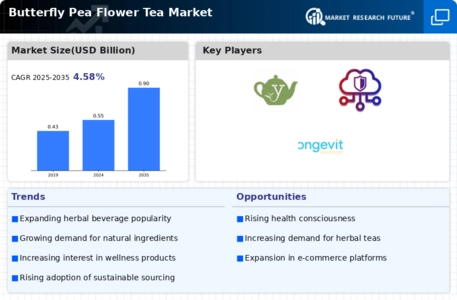Top Industry Leaders in the Butterfly Pea Flower Tea Market

Strategies Adopted by Butterfly Pea Flower Tea Key Players
The Competitive Landscape of the Butterfly Pea Flower Tea Market is influenced by a blend of established players and new entrants responding to the growing consumer interest in unique and health-conscious beverage options.
Key players in this market, such as
- Siam Industries International (Thailand)
- Yumchaa (London)
- Manila Superfoods (Philippines)
- Woodland Foods (US)
- My Blue Tea (Australia)
- ÉsahTea (India)
- Shyali Products Private Limited (India)
- Wild Hibiscus Flower Co. (Australia)
- Blue Tea (India)
- Longevity Warehouse (US)
Key players in the Butterfly Pea Flower Tea market have strategically positioned themselves by leveraging diverse strategies. Company Alpha, known for its premium offerings, focuses on brand building and marketing to emphasize the health benefits of butterfly pea flower-infused teas. Company Beta has pursued a market penetration strategy, establishing a robust distribution network to ensure widespread availability of its products. Meanwhile, Company Gamma has emphasized product diversification, introducing various flavored blends to cater to diverse consumer preferences.
Strategies adopted by these key players extend to product innovation, packaging, and marketing efforts to differentiate their offerings. The development of unique tea blends, eco-friendly packaging, and engaging marketing campaigns have been central to capturing consumer attention and establishing brand loyalty. Companies also explore partnerships with retailers and collaborate with influencers to enhance visibility and reach a broader audience.
Market share analysis in the Butterfly Pea Flower Tea industry involves evaluating multiple factors. Quality of the tea leaves, flavor profiles, pricing strategies, and effective distribution channels are critical determinants of market share. Key players invest in maintaining consistent tea quality, ensuring that their products stand out in terms of taste and overall consumer experience. Building strong relationships with suppliers to secure a steady supply of butterfly pea flowers is also crucial for sustaining market share.
New and emerging companies are entering the Butterfly Pea Flower Tea market, drawn by the increasing popularity of herbal and functional beverages. These companies often focus on innovation, experimenting with unique blends and incorporating additional health-promoting ingredients. Their agility allows them to quickly respond to changing consumer preferences, contributing to the overall dynamism and competitiveness of the industry.
Industry news and updates play a significant role in shaping the competitive landscape. Regular announcements of product launches, partnerships, and expansions provide insights into market trends and the strategies adopted by key players. Companies that stay informed about industry news can position themselves strategically to respond to changing market dynamics and consumer demands.
Investment trends in the Butterfly Pea Flower Tea market underscore its growth potential. Investors are showing interest in companies that demonstrate a commitment to sustainable sourcing, product innovation, and effective marketing. Funding is often directed towards research and development activities to explore new flavors or improve the production processes. Additionally, companies are investing in marketing campaigns to create awareness and drive consumer adoption.
The overall competitive scenario in the Butterfly Pea Flower Tea industry is characterized by a blend of competition and collaboration. While key players vie for market share through differentiated products and strategic partnerships, there is also a collaborative spirit within the industry, with some companies exploring joint ventures or collaborations to expand their reach and share expertise.
A notable development in the Butterfly Pea Flower Tea market is the increased focus on sustainability. Key players have taken steps to ensure the responsible sourcing of butterfly pea flowers and have introduced eco-friendly packaging options. This development aligns with the growing consumer preference for sustainable and environmentally conscious products. Additionally, some companies have introduced new blends with added functional benefits, capitalizing on the trend of health-conscious beverage choices.

- Beta
Beta feature
- Beta
Beta feature









